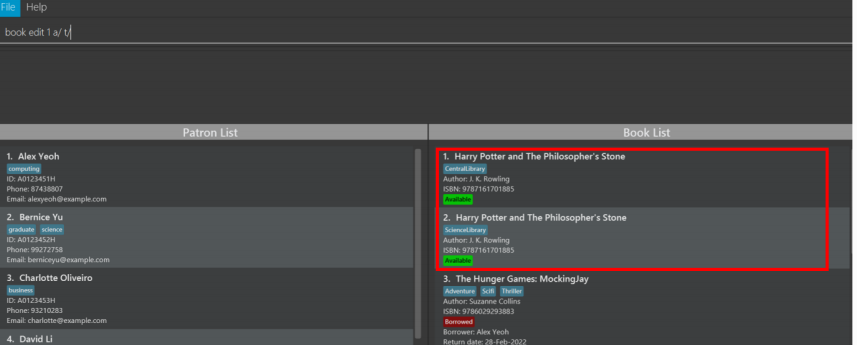Team's Response
The list of books in the UG does not need to match the sample data you get when first launching the app.. There is no point in doing so because you may have tried other commands (e.g. commands A,B,C) before looking at the UG section of another command D, so the state of your app at that point of time wouldn’t be the same as the initial anyway..
With that being said, the purpose of diagrams in UG is to illustrate certain concepts and variation of commands.. Take the below example shown for book edit command. This diagram purposely shows 2 books with Harry Potter and the Philosopher’s Stone, with same authors and isbn but different tags. This data is different from the sample data because the intention of the example is to show you that, if you edit one copy of a book, the names and author of all its copies will be edited as well, but not the tags of other copies.

Back to the example on request command,It is reasonable to assume that there are other copies of the book below, but are not shown (such that Introduction to Algorithms has more than one copy). The purpose of showing 2 requesters for introduction to the algorithm is so that you see that reminders are sent to the user for them to notify all requesters (this cannot be achieved if there is only one requester for Introduction To Algorithms).
Items for the Tester to Verify
:question: Issue response
Team chose [response.Rejected]
- [x] I disagree
Reason for disagreement: It is reasonably intuitive to expect that a new user would be confused by the example. After all, in the counter example image provided, there are two books presented - which is exactly what is expected to be in the first example.
Classifying as low, therefore is fair. Some people will be confused, probably would be able to figure it out, but at a slight inconvenience at realizing that the provided example probably had another identical book out of view.
UG indicates that:
In the preceding example in 3.3.7, there seems to suggest that the book in the example can be requested twice.
But in the start-up dummy data, there is no two books with "Introduction to Algorithms", which can be confusing when a user tries to do this example.